

Deceptively powerful moonshot tech could bring clean water to billions. For those who live in big Western cities or affluent suburbs, where your drinking water comes from is an almost invisible part of daily life.

Sustainable grains for baking bread — and fighting climate change - Washington Post. Lab grown chicken nuggets makes cruelty-free meat possible. A restaurant in Singapore recently served the world's first lab grown chicken nuggets.
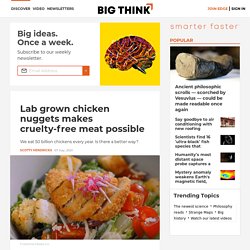
Grown from animal cells, the nuggets taste like chicken because they are made from real chicken.The lab grown chicken is only available in Singapore, though regulatory agencies in other countries are considering approval. Murder-Free Chicken Nuggets: Real Meat Grown In a Lab www.freethink.com It has never been easier to find a meat substitute at your local restaurant. Plant burgers and seitan poultry are increasingly available as solutions to the ethical, environmental, and economic problems of meat production. Now, a new option has come along: lab grown chicken. Why we need lab grown chicken. Mixed up membrane desalinates water with 99.99 percent efficiency. That ancient mariner was onto something when he said “water, water everywhere, nor any drop to drink” – the vast majority of water on Earth is undrinkable.
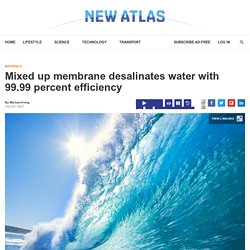
Desalination could be a vital technology to meet the world’s drinking water needs, and now Korean engineers have developed a new nanofiber membrane that can operate efficiently for long periods. There are a few different ways to desalinate water, but this study focuses on membrane distillation. In this process, the salty brine on one side of the membrane is heated, while the fresh water on the other side remains cold. The membrane is hydrophobic to repel the liquid water, but water vapor from the hot side can still pass through the pores. Due to a vapor pressure difference it drifts over to the cold side, where it recondenses as fresh water.
The rice of the sea: how a tiny grain could change the way humanity eats. Growing up in southern Spain, Ángel León paid little attention to the meadows of seagrass that fringed the turquoise waters near his home, their slender blades grazing him as he swam in the Bay of Cádiz.
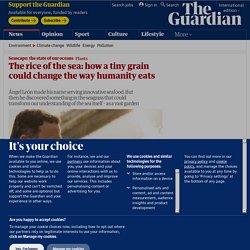
It was only decades later – as he was fast becoming known as one of the country’s most innovative chefs – that he noticed something he had missed in previous encounters with Zostera marina: a clutch of tiny green grains clinging to the base of the eelgrass. His culinary instincts, honed over years in the kitchen of his restaurant Aponiente, kicked in. Could this marine grain be edible? Lab tests hinted at its tremendous potential: gluten-free, high in omega-6 and -9 fatty acids, and contains 50% more protein than rice per grain, according to Aponiente’s research. Seaweed supplements cut cattle methane emissions by up to 82% Cattle are a major source of greenhouse gas emissions, mainly due to their methane-loaded burps.

A detailed new study has found more evidence that feeding cows a small seaweed supplement can greatly reduce their methane emissions, without affecting their health or the taste of the meat. Methane might not be as abundant a greenhouse gas as carbon dioxide, but it makes up for that in potency – over a 20-year period it traps 84 times more heat than CO2. Agriculture is the biggest contributor of the gas, with livestock belching out 37 percent of all human-induced methane. As such, calls are increasingly being made for people to reduce the amount of red meat they eat. The Savory Possibilities of Sea Beans. Article body copy.
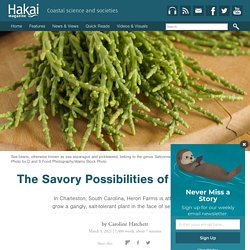
The Plan to Rear Fish on the Moon. Article body copy The seabass eggs, all 200 of them, were settled in their module and ready to go.
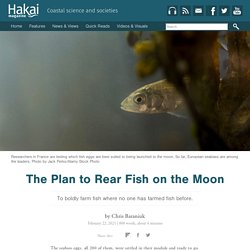
The ground crew had counted the eggs carefully, checked each for an embryo, and sealed them tightly within a curved dish filled precisely to the brim with seawater. Underground parking lots are being turned into mushroom farms in Paris. How a Vertical Farm Can Grow 80,000 Pounds of Produce per Week — Dan Does. This company is solving America's food issues one backyard at a time. This startup says seaweed is the secret to a better faux burger — and a healthier climate. Seaweed is loaded with protein, brimming with carbohydrates and, yes, grows like a weed, which explains why it has been a staple of many Asian diets since prehistoric times.
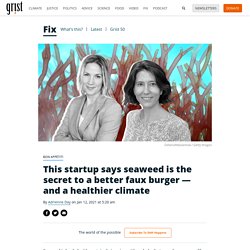
Still, seaweed is hardly ubiquitous on Western dinner plates, and the thought of it monopolizing a meal might give some people pause. Crab-22: how Norway's fisheries got rich – but on an invasive species. The Norwegian fishing village of Bugøynes, 310 miles north of the Arctic Circle and a frigid, dark place for much of the year, was on the edge of ruin.

Work was scarce. Years of overfishing and mismanagement had stymied cod quotas. Boats lay idle in cold waters. Scientists grew trees from 2000-year-old seeds and the outcome may be delicious. Two thousand years ago, the Roman Empire dominated the world, and it had a favorite fruit — dates.
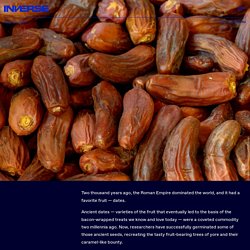
Ancient dates — varieties of the fruit that eventually led to the basis of the bacon-wrapped treats we know and love today — were a coveted commodity two millennia ago. Now, researchers have successfully germinated some of those ancient seeds, recreating the tasty fruit-bearing trees of yore and their caramel-like bounty. In a study published Wednesday in the journal Science Advances, researchers describe how they were able to grow date-palm trees from six 2,000-year-old seeds found in southern Israel. The seeds are a little different to modern-day date-palm seeds — they are “significantly longer and wider than both modern date varieties and wild date palms,” say the researchers.
In Mexico City, the coronavirus is bringing back Aztec-era ‘floating gardens’ This story was originally published by Atlas Obscura and is reproduced here as part of the Climate Desk collaboration. In the south of Mexico City, about 100 miles of murky canals wind their way through the Xochimilco neighborhood. Here, the urban sprawl of one of the world’s densest cities yields to a lake region where indigenous farmers have been cultivating a unique system of floating gardens since precolonial times. Called chinampas, these floating gardens were built by the Aztecs to feed a growing population.
Xochimilco became one of the city’s main sources of food, but rapid urbanization in the 1900s meant less land available for farming. Harvester pulls record amount of drinking water out of thin air. Clean water is all around us, and more literally than you might think – it's floating around in the air most of the time. Of course, it’s not particularly drinkable in that form, but now researchers at the Johns Hopkins Applied Physics Lab (APL) have found materials that can collect huge amounts of water from the air. As is the case with similar systems we've covered previously, the key lies with a material called a metal-organic framework (MOF).
These structures have the highest surface area of any known material – in fact, if you were able to unfold just one gram of an MOF, it would be enough to cover a football field. And all that internal space makes them perfect for capturing and storing water. Almonds are out. Dairy is a disaster. So what milk should we drink?
For environmentally minded consumers, the news is hard to swallow: almond milk is not healthy for the planet and the popular milk substitute is especially hard on bees. Our recent investigation into the connection between California’s industrialized almond industry and a record 50bn commercial bee deaths created quite a buzz. The widely read story prompted one primary response from readers: “What should we be drinking instead?” This is a thorny question, and food sustainability experts are reluctant to single out any one plant milk as best because all have pros and cons.
But we’re going to try. One thing is clear. Kenya Installs The First Solar Power Plant That Transforms Ocean Water Into Drinking Water. While most of us, who also have the privilege of using the Internet on a daily basis and therefore are able to read this, don’t have any problems getting fresh drinking water, that’s not the case for everyone. Around 2.2 billion people struggle because they don’t have safe access to drinking water which could seem pretty ironic considering we live on a planet that is 2/3 water.
But no need for those long faces as there might be a solution to this problem. Recently, the NGO Give Power installed a solar-powered plant that transforms salty ocean water into fresh drinking water and thus helps 25,000 people a day! More info: Give Power The NGO, Give Power, conducted their first solar-powered water transforming plant test early in August this year. Harvester Turns Water Into Air. Mathieu Prévot, UC Berkeley Researchers at UC Berkeley created a water harvester that can pull more than five cups of water from low humidity air per day per 2.2 pounds of water-absorbing materials.The goal is to create massive systems to harvest water for entire villages.This method actually produces enough water for you to survive in extreme circumstances, with some left to spare.
It sounds like a magic trick, but in a new paper for the Journal of the American Chemical Society, researchers from the University of California, Berkeley have unveiled a device that can literally turn thin air into water. How Microbes Could Upend America’s Toxic Dependence on Nitrogen Fertilizer. Crabs, clams, and worms die almost immediately. Fish, shrimp, and any animal that can swim quickly enough make valiant, though often doomed, efforts to flee. Meet the guy who’s farming the seas to save them. When Bren Smith first started farming kelp, he was embarrassed. Keep eating fish; it’s the best way to feed the world.
America’s Next Agricultural Revolution Will Happen Indoors. Local startup dives into the seafood snack industry. Burger King introduces meat-free Impossible Whopper. Reclaimed smoke-stack mineral could help grow crops. Scientists develop eco-friendlier way of making olives palatable. Scientists hack plant photosynthesis to boost crop yields by 40% Edible film kills bacteria in seafood. Atlasobscura. Abandoned Coal Mines Could Be Future of Farming. Device uses salty hydrogel to pull drinking water from the air. Autonomous underwater robot hunts and harvests massively invasive lionfish. New solar still claims near-perfect efficiency in purifying water. Access to clean water is one of the world's most pressing problems, but a team of University at Buffalo researchers has come up with a new take on an old technology that uses sunlight to purify water.
Led by associate professor of electrical engineering Qiaoqiang Gan, the team has created a device that uses black, carbon-dipped paper to produce fresh water with what is claimed to be near-perfect efficiency. Salon. The Trouble With Tuna Poke Bowls – Mother Jones. Looking for news you can trust? This indoor farm in New Jersey can grow 365 days a year and uses 95% less water than a typical farm. Graphene-based water filter produces drinkable water in just one step. Meet the New Meat: PredicTED by OZY. Growing food from mattresses: what experts can learn from working in refugee camps. I am a scientist who has spent his career working with industry at the interface of science, engineering and medicine.
The great nutrient collapse. Why John Deere Just Spent $305 Million on a Lettuce-Farming Robot. This Tiny Country Feeds the World. This Bioengineered Yeast Can Turn Astronaut Urine Into Food and Plastic - Seeker. Farming fish in a tiny percentage of the oceans could feed the world. The Peruvian Chef Daring to Serve Recycled Food — and End Hunger Nationwide. Freight Farms Builds Farms in Shipping Containers, and NASA Wants to Launch Them to Space. Plant-based packaging could reduce food waste. "SodaStream" technique delivers low-cost, filter-free water purification. Earth - The tree that shaped human history. Robots Are Growing Tons of Our Food. Here's the Creepy Part. Honey bee brood – a good source of food? Cell to table: Device will let you start with plant cells, end with food.
Ramping up nitrogen flow kicks soybeans into overdrive. Scientists: Deep-sea fish can solve world food shortages. Untitled. Algae: the future sustainable super crop. "Magic" native Australian tobacco plant could be key to space-based food production. How to feed the world, with a little kelp from our friends (the oceans) Growing Underground farms greens in forgotten tunnels below London. He Holds The Patent That Could DESTROY Monsanto And Change The World! Freight Farms: How Boston Gets Local Greens, Even When Buried In Snow. Africa's Ancient Plant Diversity And Seed Independence Still Under Threat From Proposed New Laws.
How To Turn A "Dead" Lawn Into An Abundant Living Garden - No Digging Required - Walden Labs. Diaper-grown mushrooms to cut down waste. Tantalising tentacles: octopus could be the next big thing in aquaculture. A Food Crisis Follows Africa's Ebola Crisis. Tooth Tales: Prehistoric Plaque Reveals Early Humans Ate Weeds. The fish feed of the future grows in the woods. If Local Farms Aren't Local Enough, Buy From The Rooftop : The Salt. Six legs tasty: First edible insect farm opens in US - life - 23 May 2014. Toshiba expands to food production with indoor vegetable factory. The Future Of Clean, Green Fish Farming Could Be Indoor Factories : The Salt. An Innovative Plan To Reel In Sport Fishermen To Feed The Hungry : The Salt. How Food Hubs Are Helping New Farmers Break Into Local Food : The Salt. A Smartypants Scientist Makes An Easy Analogy About Our Planet, And Now I'm Scared. They're Back! Chesapeake Oysters Return To Menus After Rebound : The Salt.
Between Pigs And Anchovies: Where Humans Rank On The Food Chain : The Salt. Fuel Your Body With Algae Headgear. Scientists: Use animal manure's stinking wealth of resources. Send in the Cows (or, How to Reverse Desertification, Build Soils, and Sequester Carbon) Making Food From Flies (It's Not That Icky) : The Salt. Replacing food: An engineer's approach to body fuel. Community Gardening: The Plot Against Hunger. New process could allow any plant to serve as a food source. Robotic Bees to Pollinate Monsanto Crops. Cheese waste can replace antibiotics in pig feed. Light can reveal salmon fillet. University of Sydney developing robots to automate Australian farms. From Exhausted Suburban LAWN to Supercharged Food System? Food shortages could force world into vegetarianism, warn scientists.